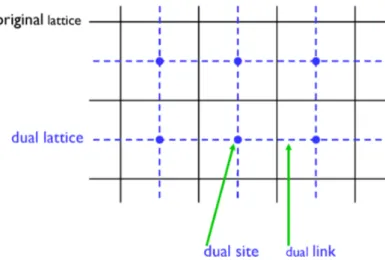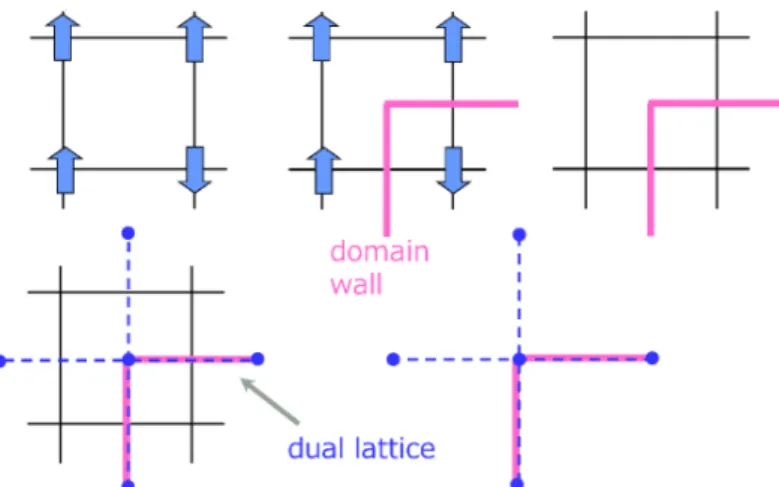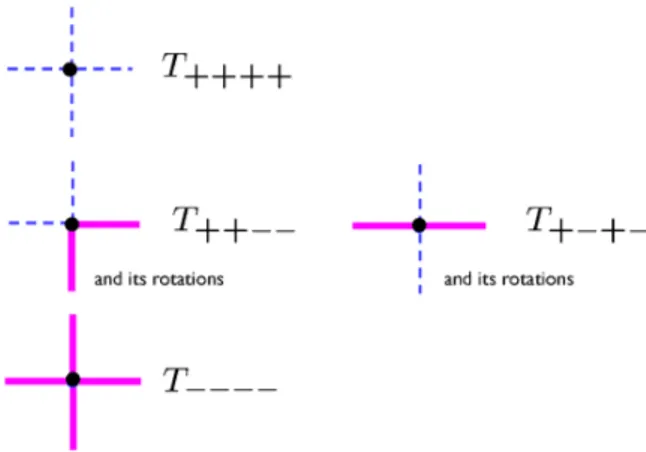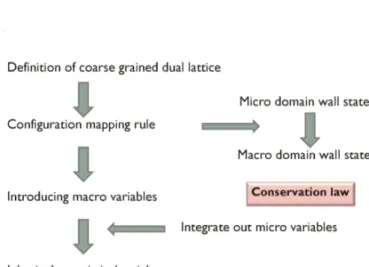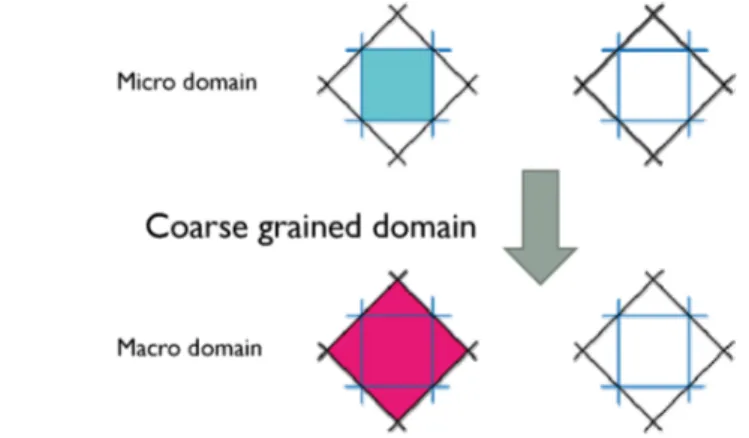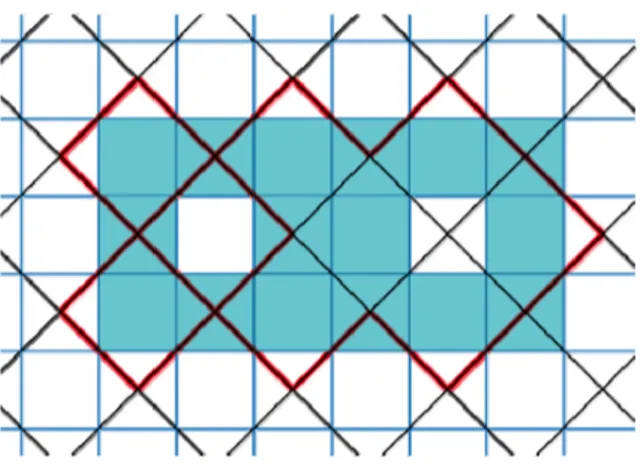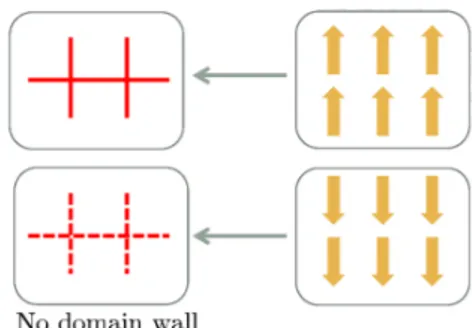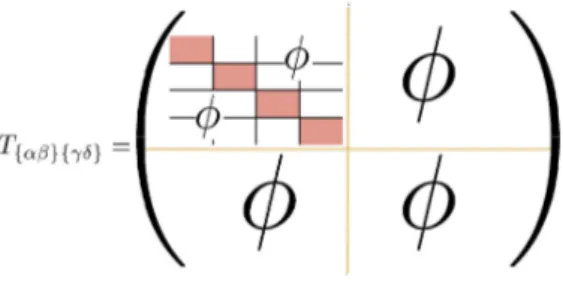Domain
Wall
Renormalization Group
Approach
to
the
$2d$Ising Model
with
External Magnetic Field
Ken-Ichi
Aoki,1,
$*$Yasuhiro
Fujii
1,$\dagger$Tamao
Kobayashi,
2,$\ddagger$Daisuke
Sat
0l,\S
and Hiroshi
Tomita1,1
$|$1
lnstitute
for
Theoretical Physics, Kanazawa University
2
Department
of
Liberal Arts, Yonago National College
of
Technology
Abstract
We represent the spin configuration of 2-dimensional Ising model by the
do-main wall configuration defined on the dual link and formulate the domain wall
renormalization group (DWRG) according to the tensor network renormalization
technique. In this report, DWRG is extended to include the external magnetic
field by introducing the oriented domain wall variables. The renormalization group transformation is obtained in 6 dimensional parameter space completely
analyti-callyand its eigenvalues around the non-trivial fixed pointis calculated to give the
magnetic susceptibility exponent.
1
Introduction
The 2-dimensional Ising model is
one
of the bestworkbenches for non-perturbativerenor-malization group approach [1], because it has non-trivial spontaneous magnetization and also the Onsager’s exact solution as the leading guide. In fact, various Renormalization
Group (RG) approaches for the model has been already proposed.
The domain wall renormalization group (DWRG) [5] is a new typeof renormalization
group method adopting the tensor renormalization group (TRG) [2] technique. TRG
has been applied to various models, particularly classical and quantum spin models in
2-dimension [3, 4].
In domain wall representation, there has been aremaining non-trivial problem of how
to calculate magnetic exponents. Our aim here is to propose a simple extension of our
method [5] to include the external magnetic field.
$*e$-mailaddress: aoki@hep.s.kanazawa-u.ac.jp
$\dagger_{e}$
-mailaddress: $y$-fujii@hep.$s$.kanazawa-u.ac.jp
$\ddagger_{e}$
-mailaddress: kobayasi@yonago-k.ac.jp
$\S_{e}$
-mail address: satodai@hep.s.kanazawa-u.ac.jp
$\eta_{e}$
2
Domain Wall
Representation
Domain walls
are
the boundary ofspin up or down domains. The domain wall variablesare
best puton
the dual links defined in Fig.1, wherethe solid lines represent the original square lattice and thedashed
lines represent the dual lattice which is also square. The dual links correspond to the boundary of every neighboring spins.Figure 1: Dual lattice of the $2d$ square lattice.
The domain wall variables thus reside
on
the dual linksas
shown in Fig.2. Spinvariables
are
$\sigma_{i}=\pm 1$ and domain wall variables are defined by $\alpha_{ij}=\sigma_{i}\sigma_{j}$, and it maytake two values: $\alpha=+1$ represents
no
domain wall and $\alpha=-1$ represents the existenceof the domain wall.
Figure 2: Definition of domain walls.
Anyspinconfiguration
can
be representedbya
domain wall configuration. Asshown inFig.3,thedomain wallvariables
on
thefour links sharing asingledual siteare
determinedby four spins around it. We regard the final part of Fig.3
as
thedomain wall vertexdefined onthe dual site.However, the correspondence between spins and domain wallsare not
one
toone.
Tow spin configurations $\{\sigma_{i}\},$ $\{-\sigma_{i}\}$are
mappedto the single domain wall configuration $\{\alpha_{ij}\}$and this is two to one mapping. Therefore, although there
seems
to be no spontaneous symmetry breaking in the domain wall representation, its partition function or the freeenergy has the exactly
same
singularitiesas
the original spin partition function.Figure 3: Domain wall representation of spin configuration.
The domain walls constitute the boundary of spin up or down domains, and therefore
the domain wall is conservative and makes topologically loop objects. Then the
non-conservative odd vertices as shown in Fig.4 are prohibited. $\prime$ 1 1 $–rightarrow$ 1 1 $\bullet/$
Figure 4: Prohibited non-conservative vertices.
Then wedefine the vertex tensor at each dual site, whichis a function of four domain wall variables around the dual site asshown in Fig.5. Sinceit has foursuffices, it is called the tensor.
$\alpha$
$T$
$T_{\alpha\beta\gamma\delta} \beta---|---\delta|$
$\gamma$
Figure 5: Vertex tensor.
The value of the vertex isdeterminedsothat the total product and the total summation withrespect tothe domain wall variables givethepartitionfunction of the original system
as
shown in Fig.6. The factor 2 at the top represents the two to one mapping nature of domain wall configuration versus spin configuration,$\beta$
$Z=2$ $\sum T_{\alpha\beta\delta\gamma}T_{\delta\mu\nu\rho}\cdots$ $\alpha\beta\delta\gamma$
Figure 6: Partition function.
Therefore, the vertex value is proportional to the square root of the local statistical weight of the configuration. In caseof non-conservativevertex, the statistical weight must
vanish. Then the non-vanishing elements of this $2\cross 2\cross 2\cross 2$ tensor are only 8 elements
as
shown in Fig.7 1 $—+–\cdot T_{++++}$1/’
$—\ulcorner_{and_{I}csro\iota at/ons}T_{++--}$ andits$ro\iota z\iota j\circ nsT_{+-+-}$
Figure
7:
Non-vanishing elements oftensor.3
Domain wall renormalization
group.
In this section we discuss how to define the renormalization group transformation in the domain wall representation, that is, renormalization of its vertex tensor $T$. The basic
strategy to define the renormalization group is flow-charted step by step in Fig.8.
According to this chart, first we define
coarse
graining ofthe dual lattice. We definethe coarse grained original lattice alaWilson [1], and then the
coarse
grained dual lattice is automatically definedas
in Fig.9.Note here that the
coarse
graining of original lattice keepsa
half of their sitescom-monly, while the
coarse
graining of dual lattice hasno common
sitenor
link. In terms ofdecimation, the
coarse
graining oflattice is obtained by decimation of sites, whereas thecoarse
graining ofdual lattice is obtained by decimation of domains (dual plackets).Then we define the
coarse
grained domain statusas
shown in Fig.10. Note that theDefinitionofcoarsegrained dual lattice
$Configuratio\cap l$
mapping rule
$-$
Micro domain$wa\ovalbox{\tt\small REJECT}\ovalbox{\tt\small REJECT}$
state
1.
1
Macro$doma/nwa\ovalbox{\tt\small REJECT}\ovalbox{\tt\small REJECT}$state
’$ntroduc/ng$macrovariables
$1$
$-$
integrateoutmicrovariablesInherit the statistical weight:
Effective interactionsgiven byafunction ofmacrovariables
Figure 8: Domain wall renormalization group.
$arrow$ Decimating sites $arrow$ Decimating domains Figure 9: Coarse graining lattice and dual lattice.
The
coarse
grained domain status is just equal to the micro domain status at the center of it.Figure 10: Definition ofcoarse grained domains.
Next, the
coarse
grained domain wallsare
defined by the boundary of thecoarse
grained domains. Thus
we
get the mapping function from micro domain wallconfigura-tion to the macro domain wall configuration. In Fig.11 we show the mapping function,
where the blue dual link denotes the micro domain wall and the red coarse grained dual
link denotes the macro
coarse
grained domain wall. The 4 configurations in the upperrow correspond to non-existence of the
macro
domain wall and those in the lower rowcorrespond to existence of the
macro
domain wall respectively. It is the eight to tworeduction mapping and this is the
coarse
graining of domain walls.Figure 11: Macro domain walls and the mapping function.
It should be noted here that the
macro coarse
grained domain walls are boundary ofthe
coarse
grained domains, and accordingly themacro
domain walls are also conservedby themselves.
An example of the
coarse
graining ofdomain walls is shown in Fig.12. The left small island survives thecoarse
graining whereas the rightone
disappears.Now the most non-trivial part
comes
up. We have defined the domain wall mappingfunction between micro and
macro.
Thus the macro domain wall configuration must haveFigure 12:
Coarse
graining example.domain wall configuration. And also the macro domain wall weight must be represented
by the renormalized tensor vertex. To make this procedure
we
learn from the tensor network renormalizationtechnique.First of all, we split the micro domain
wa114-vertex
$T$ intoa
product of3-vertices $S$as
shown in Fig.13, which is something like transforming the four-fermi interactions intoa pair of yukawa interactions by introducing auxiliary scalar fields. This decomposition is performed by the following matrix diagonalization,
$T=UDV$, (1)
where tensor $T$ is regarded as a matrix by grouping the domain wall indices as $T_{\{\alpha\beta\}\{\gamma\delta\}}$
and $U,$ $V$ are unitary matrices. The resultant matrix $D$ is a diagonal matrix of singular
values $\lambda_{M}$ which are all positive semi-definite. Then we can define $S$ as
$T_{\alpha\beta\gamma\delta}= \sum_{M}U_{\alpha\beta M}\sqrt{\lambda_{M}}\sqrt{\lambda_{M}}V_{M\gamma\delta}=S_{1\alpha\beta M}S_{2\gamma\delta M}$ , (2)
$S_{1\alpha\beta\Lambda I}=U_{\alpha\beta l1f}\sqrt{\lambda_{M}}, S_{2\gamma\delta M}\sqrt{\lambda_{M}}V_{M\gamma\delta}$ . (3)
Actually our $T$ matrix is
a
symmetric real matrix and it can be diagonalized by theorthogonal transformation, that is, we have $S_{1}=S_{2}.$
$\alpha|$
$\alpha^{1}$
$-\beta+_{\wedge}\tau^{\delta}-(D^{rightarrow\beta\backslash _{M}^{S}}\backslash_{\gamma_{I}}s_{\delta-}$
–
Figure
13:
Splitting vertex $T$. Figure14:
Renormalizationof
$T.$We like to consider the scalar particle index $M$
as
themacro
domain wall variable. Herewehave to dosome
approximation. Sincethe renormalized domain wall has only twostates naively, while the index $M$ has 4 degrees of freedomto satisfy theabove equation.
Then we adopt the approximation that only the relatively important channels should be
kept, that is, only two indices $M$ are taken among four. This is the approximation we have to do to define the domain wall renormalization group.
Next we integrate out all original domain wall indices $\alpha,$$\beta,$$\gamma,$ $\cdot$ and we get the effective weight function of$M$ at each
coarse
grained (renormalized) dual link, where $M$ is regardedas
the renormalized domain wall variable. The effective weightfunction
is written by the renormalized vertex tensor $T’$ defined by$T_{MNKL}’= \sum_{\alpha\beta\gamma\delta}S_{\alpha\beta M}S_{\beta\gamma N}S_{\gamma\delta K}S_{\delta\alpha L}$ . (4)
Thisprocess is understandable
as
integrating out original fermion fields to leave effectiveinteractions among scalar fields, and it is graphically expressed in Fig.14.
The global landscape is drawn inFigs.15 and
16.
After therenormalizationprocedure, the renormalized dual lattice has $\sqrt{2}$ times larger spacing. This transformation can berepeated and we have completed to define the domain wall renormalization group in the
lowest order approximation.
Figure 15: Global landscape 1. Figure 16: Global landscape 2.
The detailed analysis ofthis domainwall renormalizationgroup is foundin [5]. There,
the renormalization transformation is written down completely analytically and it is
proved that the physical selection of channels to interpret the renormalized indices as the macro domain wall variables is perfectly consistent with the optimized selection of largest singular values. Also the fixed point structure of the renormalization group flow
and the eigenvalues of the renormalization transformation around the fixed point are
calculated to give good values compared with the Onsager’s exact solution.
4
Introducing
the external
magnetic
field
So far, thereis
no
external field imposed, andno
way of calculating magnetic quantities. In this section we proposea
simple extension of the domain wall renormalization groupThe domain wall representation is adegenerate descriptionof the spin configurations, that is, it does not discriminate $Z_{2}$ inverted spin configurations, $\{\sigma\}$ and $\{-\sigma\}$. To
discriminate these $Z_{2}$ inversion we introduce orientation of the domain wall as shown in Fig.17. Our rule here is that the up spin domainis
on
the right hand side of the orienteddomain wall when moving along thearrow. Simultaneously we doublethe no-domain wall
state and call them
as
up domain and down domainas
in Fig.18. Now our domain wallvariable has four states at every dual link.
Figure 17: Oriented domain walls. Figure 18: Up domain and down domain.
$\S$ $\#$
updomain
$arrow\prime IlI$ $trightarrow\}$
Figure 19: Four domain wall states. Figure 20: $Z_{2}$ symmetry transformation.
The statistical weight is given by,
$\exp(K\sum_{<ij>}\sigma_{i}\sigma_{j}+h\sum_{i}\sigma_{i})$ (5)
where $\langle ij\rangle$
means
the nearest neighbor pair ofspins, $K$is the coupling constant and $h$ is
the external magnetic field. The four states of the domain wall variable on the dual link is diagrammatically expressed as in Fig.19. The $Z_{2}$ conjugate transformation is defined for these states as in Fig.20, which is important to understand the symmetry constraint of the vertex tensor and its renormalization transformation.
Now the indices $a,$ $\beta,$
$\gamma,$
$\delta$
of tensor $T$ takes 4 states each as in Fig.19, and tensor
$T_{\alpha\beta\gamma\delta}$ has originally $4^{4}=256$ elements. Only 16 elements are non-vanishing including rotation because of the domain wall conservation law with orientation, which
are
listed in Fig.21. In Fig.21, the barred variablemeans
$Z_{2}$ conjugate, while $a=a,$ $c=\overline{c}$ are self $Z_{2}$ conjugate.Thisdomain wallrepresentationhas 6dimensionalparameterspace$\{N, \overline{N}, b, b, a, c\}$ and
one
toone
correspondence to spin interactions $\{C_{0}, K, K_{D}, K_{4}, h, h_{3}\}$, whose$.–a^{1\underline{N}},^{--}1l$
$I_{I}\underline{\overline{b}}I^{--}I^{\cross 4}$
Figure 21: Non-vanishing
16
elements of the vertex tensor.$+_{\sigma_{2}\sigma_{3}}^{\sigma_{1}\sigma_{4}}$
$\gamma$
$\gamma$
$- \beta\lrcorner^{\alpha}\ulcorner\delta$
Figure 22: Spin configuration. Figure
23:
2-dimensional matrix.$\exp[C_{0}+K(\sigma_{1}\sigma_{2}+\sigma_{2}\sigma_{3}+\sigma_{3}\sigma_{4}+\sigma_{4}\sigma_{1})+K_{D}(\sigma_{1}\sigma_{3}+\sigma_{2}\sigma_{4})+K_{4}(\sigma_{1}\sigma_{2}\sigma_{3}\sigma_{4})$
$+h(\sigma_{1}+\sigma_{2}+\sigma_{3}+\sigma_{4})+h_{3}(\sigma_{1}\sigma_{2}\sigma_{3}+\sigma_{2}\sigma_{3}\sigma_{4}+\sigma_{3}\sigma_{4}\sigma_{1}+\sigma_{4}\sigma_{1}\sigma_{2})]$ (6)
Weuse 2-dimensionalmatrix representation$T_{\{\alpha\beta\}\{\gamma\delta\}}$ of$T_{\alpha\beta\gamma\delta}$
as
in Fig.23, and matrix$T_{\{\alpha\beta\}\{\gamma\delta\}}$ is $16\cross 16$ dimensional. Actually, non-vanishing indices $\{\alpha\beta\}$ or $\{\gamma\delta\}$ are very
much and limited
as
shown in Fig.24. Only 8 elements are non-vanishing among 16elements, and therefore $T_{\{\alpha\beta\}\{\gamma\delta\}}$ has only $8\cross 8$ non-vanishing block.
$z_{2}\downarrow \frac{t|}{---1\underline{|l}}I \lrcorner| \lrcorner t I^{\theta}$ $–\underline{S}_{r}| \underline{\mathfrak{g}_{I}^{I}l} \mathscr{Q}$
Figure 24: Non-vanishing indices.
Considering the oriented domain wall conservationlaw, possiblecombination of indices
$\{\alpha\beta\}$ and $\{\gamma\delta\}$ are summarized in Fig.25. Thus the matrix $T_{\{\alpha\beta\}\{\gamma\delta\}}$ is divided into the
even
sectionand odd section and their $Z_{2}$conjugatesections. Each sectionconsists of$2\cross 2$structure. Odd section and odd section
are
also constrained by the rotational symmetry. Accordingly, the total image of $T_{\{\alpha\beta\}\{\gamma\delta\}}$ takes the form shown in Fig.26. The matrix $T_{\{\alpha\beta\}\{\gamma\delta\}}$ is block diagonal consisting of 4 blocks of $2\cross 2$ each.Now we set up the oriented domain wall renormalization group. The renormalized
domain wall states are defined by renormalized domain states. Then each sector
Even section $\overline{Even}$section
–
$Z_{2}$ Odd section $rightarrow$ $Z_{2}$$\ovalbox{\tt\small REJECT}\ovalbox{\tt\small REJECT}$
–
rotation
Figure 25: Even and odd section.
wall interpretation through the renormalization procedure, we have to pick up one macro
channel each from every section.
Figure 26: Block diagonal matrix $T.$
Wediagonalize$T_{\{\alpha\beta\}\{\gamma\delta\}}$ as follows. Cosine and sinefunctions constituting the
orthog-onal matrices are denoted by $c_{a},$ $s_{a}$. Diagonalization ofeven sector is given by,
$(\begin{array}{ll}N bb c\end{array})=(\begin{array}{ll}c_{1} -s_{1}s_{1} c_{1}\end{array})(\begin{array}{ll}\lambda_{1} 00 \lambda_{2}\end{array})(\begin{array}{ll}c_{1} s_{1}-s_{1} c_{1}\end{array})$ (7)
$\overline{Even}$
section is expressed by usingthe $Z_{2}$ conjugate variables,
$(\begin{array}{l}\overline{N}\overline{b}\overline{b}\overline{c}\end{array})= (\overline{\frac{c_{1}}{s_{1}}} -\overline{\frac{S}{c_{1}}1})(\overline{\lambda_{1}0}\frac{0}{\lambda_{2}})(\begin{array}{ll}\overline{c_{1}} \overline{s_{1}}-\overline{s_{1}}\overline{c_{1}} \end{array})$ (8)
Odd and odd sections
are
parametrized by,$(ab \frac{a}{b})=(\begin{array}{ll}c_{2} -\mathcal{S}_{2}s_{2} c_{2}\end{array}) (\begin{array}{ll}\lambda_{3} 00 \lambda_{4}\end{array})(\begin{array}{ll}c_{2} s_{2}-s_{2} c_{2}\end{array})$ (9)
where we adopt the following $Z_{2}$ conjugation rules,
Macro Up domain Odd section$|$ $rightarrow$ $Z_{l}$ $Z_{2}$ $rightarrow$ rotation $\overline{Even}$ section $-$
.
$\dot{c}_{\backslash }\backslash$ $\ddagger$
$\backslash \backslash$
$\backslash \backslash$
$\epsilon$
$\backslash \backslash \theta\cdot\blacksquare\cdot\cdot$
$-$
:
Macro Down domain
Odd section
Macro Domain Wall
Figure 27: Macro domain wall states.
Here larger eigenvalues (selected channels) in each section
are
taken tobe$\lambda_{1},$ $\overline{\lambda_{1}},$$\lambda_{3},$ $\overline{\lambda_{3}},$ and they
are
also the 4largest singular values ofa118
singular values, whichassures
ourphysical selection is consistent with the optimized singular value decomposition policy. The Feynman rules which couples micro and
macro
domain wallsare
listedin Fig.28. Domain wallsare
conserved in total for micro andmacro.
It shouldbe noted that theyare
oriented Feynman rulesand therefore they are irreversible, that is, the example diagrams
at the bottom of Fig.28 do not exist.
$\sqrt{\lambda_{1}}c_{1}$ $rightarrow^{Z_{2}}$ $===\Rightarrow$ $\sqrt{\overline{\lambda_{1}}}\overline{c_{1}}$ $\sqrt{\lambda_{1}}s_{1}$ $===\ll$ $\sqrt{\overline{\lambda_{1}}}\overline{s_{1}}$ $\sqrt{\lambda_{3}}c_{2}$ $\sqrt{\lambda_{3}}s_{2}$ $\sqrt{\lambda_{3}}s_{2}$ $\sqrt{\lambda_{3}}c_{2}$ e.g.
Figure
28:
Feynman rules between micro andmacro.
Renormalization transformation is carried out by calculating the one-loop diagrams
For example $a’$ and $c’$ keep $Z_{2}$ self conjugateness.
From the statistical weight defined in Eq.(5), the physical initial values of these 6
parameters are given by,
$N = e^{2K+h}\ovalbox{\tt\small REJECT}\overline{N}=e^{2K-h}$
$b = e^{h/2}rightarrow\overline{b}=e^{-h/2}$
$a = 1, c=e^{-2K}$ (11)
where left and right handed sides $ofrightarrow areZ_{2}$ conjugate to each other.
Now
we
write down the renormalization group transformation explicitly and analyti-cally as follows,$\lambda_{1} = \frac{1}{2}(N+C+\sqrt{(N-C)^{2}+4b^{2}})$
$\overline{\lambda_{1}}= \frac{1}{2}(\overline{N}+C+\sqrt{(\overline{N}-C)^{2}+4\overline{b}^{2}})$
$\lambda_{3} = \frac{1}{2}(b-\overline{b}+\sqrt{(b-\overline{b})^{2}+4a^{2}})$
$t_{1} = \frac{1}{b}(\lambda_{1}-N) , t_{1}=\frac{1}{\overline{b}}(\overline{\lambda_{1}}-\overline{N}) , t_{2}=\frac{\lambda_{3}-b}{a},$
$c_{a}^{2}$ $=$ $\frac{1}{1+t_{a}^{2}}$ $s_{a}^{2}=1-c_{a}^{2}$ , for $a=\{1, \overline{1}, 2\}$ (12)
Due to the$Z_{2}$ conjugate propertyof the totalsystem, there existsa4-dimensionalsubspace
of$Z_{2}$ invariant space,
$N=\overline{N}, b=\overline{b}, a, c$ , (13)
in which the renormalization group flows are confined. Therefore this subspace is
renor-malization group invariant subspace. The renormalization group transformation in this
$Z_{2}$ invariant subspace is exactly equal to what we have obtained previously [5].
We have to find the non-trivial fixed point to evaluate critical properties of the spon-taneous magnetization. Actually, however, there is no fixed point in the transformation in Eq.(12), since the vertex tensor $T$ continues to increase due to the volume effect of
the renormalization procedure which compensates the decimation of half of the degrees
of freedom at each renormalization step. We will set
some
normalization condition of$T$ and multiply a constant factor to all elements in $T$ to satisfy it at each renormalization step. This is called the gauge fixing since such constant multiplication does not changeany physical quantities of density type objects, such as, magnetization per site etc. The position of a fixed point itself depends on the gauge fixing condition adopted, called thegaugesimply. However, the eigenvalues around the fixed point does not depend
on the gauge. Here we show a proof of it briefly. We have two gauge fixing conditions, and coordinates on the gauge fixed manifolds are denoted by $x$ and $y$ respectively. There
are gauge transformation path (fiber bundle) in the total space on which $T$ is physically equivalent. This gauge transformation defines
a
relation between $x$ and $y,$$+$ $=\lambda_{1}^{2}(c_{1}^{4}+s_{1}^{4})$
$Z_{2}\downarrow$
$a’=$
$+$
where $g$ is a non-singular function. Now the renormalization transformation are written
as
$x’=R_{1}(x) , y’=R_{2}(y)$, (15) and they have a fixed point at $x^{*}$ or $y^{*}$ satisfying,
$x^{*}=R_{1}(x^{*}) , y^{*}=R_{2}(y^{*}) , y^{*}=g(x^{*})$. (16)
The eigenvalues for $x$ and $y$ spaces are denoted by $\lambda_{1}$ and $\lambda_{2}$ respectively, and they are calculated to coincide with each other as follows,
$\lambda_{1} = R_{1}’(x^{*})=\frac{d}{dx}[g^{-1}(R_{2}(g(x^{*})))]=g^{-1/}(R_{2}(g(x^{*})))R_{2}’(g(x^{*}))g’(x^{*})$
$= g^{-1/}(y^{*})R_{2}’(y^{*})g’(x^{*})=R_{2}’(y^{*})=\lambda_{2}$ (17)
After the gauge fixing, the effective dimension ofthe total parameter space is five. In the $Z_{2}$ invariant 3-dimensional subspace
we
have found a non-trivial fixed point [5]. Thisfixed point is also a fixed point in the tota15-dimensiona1 space. The eigenvalues around thefixed point consist of three $Z_{2}$
even
eigenvalues and two $Z_{2}$ odd eigenvalues.We show transformation of variables between $\{C_{0}, K, K_{D}, K_{4}, h, h_{3}\}$ and domain
representations $\{N, \overline{N}, b, b, a, c\}$ in Fig.30, where letters in red are contributed by $Z_{2}$
odd interactions.
$Z_{2}\uparrow+C:\ N=\exp[C_{0}+2K+2K_{D}+K_{4}+h+4h_{3}]$
$\bullet\bullet\bullet 4\bullet \bullet\blacksquare \overline{N}=\exp[C_{0}+2K+2K_{D}+K_{4}-l\iota-4h_{3}]$
$i:[$
$+_{r*}^{11}$ $b= \exp[C_{0}^{\gamma}-K_{4}+\frac{h}{2}-2h_{3}]$ $Z_{2}\uparrow$ $\overline{b}=\exp[C_{0}-K_{4}-\frac{h}{2}+2h_{3}]$ $a=\exp[C_{0}-2K_{D}+K_{4}]$ $c=\exp[C_{0}-2K+2K_{D}+K_{4}]$Figure
30:
Transformation between spin and domain wall interactions.interactions $\{C_{0}, K, K_{D}, K_{4}, h, h_{3}\}$
are
given by,$C_{0} = \frac{1}{16}\log[N\overline{N}a^{4}b^{4}\overline{b}^{4}c^{2}] K=\frac{1}{8}\log[N\overline{N}/c^{2}]$
$K_{D} = \frac{1}{16}\log[N\overline{N}c^{2}/a^{4}] , K_{4}=\frac{1}{16}\log[N\overline{N}a^{4}c^{2}/b^{4}\overline{b}^{4}]$
$h = \frac{1}{4}\log[Nb^{2}/\overline{N}^{2}\overline{b}^{2}] h_{3}=\frac{1}{16}\log[N\overline{b}^{2}/\overline{N}^{2}b^{2}]$ (18)
In the actual analysis oftherenormalization group flow, we set a gaugefixing condition,
$C_{0}=0$, that is, the spin independent factor is discarded.
5
Results
The $Z_{2}$
even
quantities suchasthefreeenergy, the specific heat and the correlation lengthexponent have been reported previously [5]. Here
we
show $Z_{2}$ odd magnetic propertiesonly.
We plot typical high and low temperature flows in terms of the spin interaction pa-rameters in Fig.31 and Fig.32, where $n$ is the number of renormalization steps. In both
cases
only the single spin magnetic interaction $h$ survives at the infrared (macro) limit,since we have to work with finite correlation length situation. The difference between
high and low temperatures is seen by the final enhancement factor of$h.$
$\subset 0$
$\overline{\alpha}$
$\cup 0\supset$
$0 5101520253035$
$n$
Figure 31: High temperature flow.
In Fig.33,
we
plotted the magnetizationversus
the initial nearest neighbor coupling constant $(\alpha\equiv e^{-2K})$ for various initial external magnetic fields. Wecan see
the second order phase transition ofthe spontaneous magnetization around $\alpha=0.37036.$Finally we evaluate renormalization group eigenvalues around the non-trivial fixed
point. We have three $Z_{2}$
-even
eigenvalues,$\circ t$ $\underline{c}$ $\overline{\alpha}$ $\mathring{\cup}\supset$
$0 5101520253035$
$n$Figure 32: Low temperature flow.
and two $Z_{2}$ odd eigenvalues,
{2.0214,
1.0547}.
(20)The relevant $Z_{2}$
-even
eigenvalue gives the correlation length criticalexponent,$\nu=\frac{\log\sqrt{2}}{\log 1.4224}=0.984$ , (21)
which looksperfectcompared to the exact value of 1. Thepeculiar zeroeigenvalueappears because the renormalization group transformationin the $Z_{2}$
even
3-dimensional subspaceis actually constrained to be 2-dimensional. This seems an occasional constraint and no
physical significance is expected.
As for $Z_{2}$-odd eigenvalues, we encounter a serious deficit; there are two relevant
oper-ators. So far
we
have no good idea about how to cure this problem in this lowest orderformulation. Somenormalization issue owing to the singularity of decimation type
renor-malization group may be related. Ifwe use the larger eigenvalue to evaluate the magnetic susceptibilityexponent,we have
$\gamma=2.028$ , (22)
which looks not so good compared to the exact value of 7/4.
Wehave another idea of including the external magnetic field in the dualrepresentation
of the domain wall representation. Analysis of this dual renormalization group will be reported elsewhere [6].
Acknowledgments
We thank Yusuke Yoshimura for fruitful and critical discussion and comments, and
$\mathring{\underline{=c\varpi N}}$
$\dot{=oc\Phi\varpi}’$
Figure
33:
Magnetizationversus
temperature.References
[1] L.P. Kadanoff, Physics. 2 (1966)
263.
K.
G.
Wilson, Rev. Mod. Phys. 47 (1975)773
[2] M. Levin and C. P. Nave, Phys. Rev. Lett. 99 (2007)
120601.
[3] M. Hinczewski and A. N. Berker, Phys. Rev. E77 (2008)
011104.
[4] Z.-C. Gu, M. Levin andX.G. Wen, Phys. Rev. B78(2008)
205116
andarXiv:0806.3509[cond-mat.str-el].
[5] K.-I. Aoki, Tamao Kobayashi and H. Tomita, Int.J.M.Phys.B23 (2009) 3739.
[6] K.-I. Aoki, Yasuhiro Fujii, Tamao Kobayashi, Daisuke Sato, Hiroshi Tomita and
